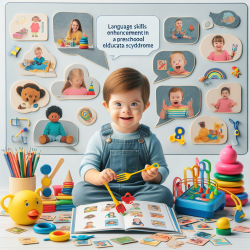As professionals dedicated to supporting the development of children with Down Syndrome, it's crucial to continually refine our approaches based on emerging research. A pivotal study, "Facilitating The Acquisition of Two-Word Semantic Relations By Preschoolers With Down Syndrome: Efficacy of Interactive Versus Didactic Therapy," provides invaluable insights into optimizing language intervention strategies. This research compares the effectiveness of interactive modeling and didactic elicitation in enhancing two-word utterances, shedding light on methods that may significantly impact our practice.
The study's design meticulously alternated between interactive and didactic treatments, offering each child 140 minutes of therapy per condition over six weeks. The results indicated a notable efficiency in learning specific target items and generalizing underlying semantic rules in the didactic condition, suggesting a potentially advantageous approach for children with Down Syndrome who face word-finding and oral-motor speech challenges.
Given these findings, practitioners are encouraged to integrate didactic elements into therapy sessions, especially for those children demonstrating similar challenges. However, this does not undermine the value of interactive methods but rather highlights the importance of a tailored approach. To enhance skill acquisition:
- Employ Theme-Based Didactic Activities: Embed didactic teaching within naturalistic play themes to address intrinsic language needs while maintaining engagement.
- Systematic Elicitation: Incorporate structured elicitation of target phrases within sessions, ensuring frequent practice and immediate feedback.
- Monitor and Adapt: Observe the child's response to each method, ready to adjust based on their unique learning pace and style.
- Encourage Generalization: While didactic methods showed more efficient learning of specific targets, integrating interactive methods can aid in generalizing skills to conversational contexts.
- Parental Involvement: Educate families on reinforcing target phrases in daily interactions, enhancing the transfer of learned skills to natural settings.
Moreover, this study underscores the necessity of individualized intervention plans. Children with Down Syndrome present diverse profiles, necessitating approaches that cater to their specific needs and strengths. As such, collaboration with a multidisciplinary team, including speech-language pathologists, occupational therapists, and educators, is vital to develop comprehensive, effective intervention strategies.
Further research is imperative to build on these findings, exploring long-term outcomes and the potential for integrating didactic and interactive methods. As practitioners, staying informed and flexible in our approaches allows us to provide the best possible support to our students, guiding them toward successful communication outcomes.
For those interested in delving deeper into the research and its implications for practice, I highly recommend reviewing the original study. It offers a thorough analysis and valuable insights that can enhance our therapeutic strategies for preschoolers with Down Syndrome. To read the original research paper, please follow this link: Facilitating The Acquisition of Two-Word Semantic Relations By Preschoolers With Down Syndrome: Efficacy of Interactive Versus Didactic Therapy.
In conclusion, the journey of enhancing language skills in children with Down Syndrome is a collaborative, dynamic process. By integrating research-based practices and tailoring our approaches to each child's needs, we can make significant strides in supporting their communication development.










